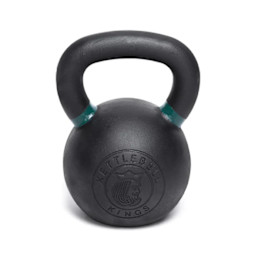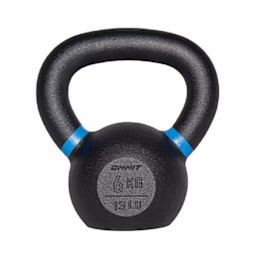
At this point, we're all clear on the fact that strength training is nonnegotiable in any fitness routine. And if you're going the home gym route, it's good to know you have options beyond a set of dumbbells and some resistance bands. Enter the kettlebell: a wonderfully versatile piece of equipment that adds some much-needed variability to any workout.
Read on for expert insight into this home gym MVP from three certified personal trainers, plus our picks for the six best kettlebells for all your lifting needs.
The best kettlebells for beginners of 2023:
Why use a kettlebell at home?
"Adding kettlebells to your home gym opens up a wide range of variations to many staple movements and many more that can only be appropriately performed with a kettlebell," says Dan Bulay, CPT, co-owner of The District Training Facility, and Everlast coach.
From squats to curls to presses, kettlebell variations allow you to challenge your muscles in different ways—and that promotes progress. Plus, some signature kettlebell moves, like kettlebell swings, can't be comfortably replicated with a dumbbell.
While both home gym staples share a similarly small footprint, kettlebells zig where dumbbells zag. "Kettlebells provide a change in weight distribution compared to a dumbbell," says Bulay. "Due to the shape of a kettlebell and the varying ways to hold it, it's possible to increase the difficulty of any physical movement during a workout."
It's true: Holding the kettlebell by its base, its handle, or even upside down affects everything from difficulty level to how the muscle is being stressed. Bulay says that's all thanks to physics and biomechanics: "Holding it in different areas changes the lever and momentum to provide either more or less difficulty and/or stability."
Summary
Types of kettlebells.
As you shop, you'll discover there are multiple versions of kettlebells, from adjustable to classic cast iron to what's known as competition kettlebells. Cast-iron and competition kettlebells are made of solid iron and steel, respectively, which makes them more durable.
- Competition kettlebells are all sized the same no matter how much they weigh, with uniform handles and color coding to indicate weight.
- Cast-iron kettlebells, on the other hand, get bigger the heavier they are.
Both options work well in a home gym, but you'll typically spend a little less for classic cast iron.
How we picked:
Type
Our focus is on picks for the kettlebell beginner, so we included cast iron, competition, and adjustable options.
Quality
Poorly made kettlebells may be easy on the wallet, but they're often not cast in a solid piece. That means potential durability and long-term performance issues. Inferior handles also set you up for grip issues and even injury.
Reviews
We reviewed feedback from customers to get an idea of how these kettlebells perform for real people and opted for those that had the highest ratings.
Price
Weight-lifting equipment can be pricey, but we looked for a range of options to suit different budgets.
The best kettlebells for beginners of 2023:
Pros
- Wide range of weights
- Color coded
- High quality
Cons
- Size increases with weight
Weight options:
13-70 lbsThe first benefit of the Onni kettlebell is the quality construction. Each kettlebell is made from solid cast iron that not only lends long-term durability but consistency throughout the base and handle. The handle features a textured powder coat that makes it easy to grip even if your hands get a little slick while you’re working out (pro tip: chalk!).
While not sold in sets, each kettlebell is color-coded according to weight. That makes it easy to grab the right weight even if you’re super-setting or moving quickly through circuits.
Just over 400 reviewers give these kettlebells top marks for quality and value.
Pros
- Clever design
- Versatile
- Portable
- Inexpensive
Cons
- Requires access to dumbbells
- Won’t work for all kettlebell exercises
Weight options:
VariesThe Kettle Gryp isn’t a kettlebell at all. Essentially, it’s a clamp—and it’s pretty clever. “A kettlebell clamp option will turn a dumbbell into a kettlebell,” explains Paul Fischer, CPT, owner of Framework Personal Training. “This is a very good option that assists in multiple uses of equipment with space considerations.”
This clamp features a simple design: open the handles, line up the dumbbell on the foam insert, close the handles, snap the latch, and you’re ready for a kettlebell workout (or pretty close to it). While the grip is similar to a kettlebell, the weight distribution is not. That means not every kettlebell exercise will work with the Gryp, and that’s especially true the heavier you go. Still, if your home gym already has dumbbells and you’re interested in basic kettlebell exercises, this might be worth a closer look.
Another plus–there are over 8,300 Amazon reviews for the Kettlebell Gryp, with an overall rating of 4.5 stars.
Best kettlebell for the money: Everyday Essentials All-Purpose Solid Cast Iron Kettlebell

Pros
- Great price point
- Built to last
- Wide handle sized to fit everyone
Cons
- May benefit from better casting and sanding to reduce rough spots
Weight options:
5-50 lbsThese cast-iron kettlebells are a solid entry-level choice with weights that increase in five-pound increments from the lightest to the heaviest. The painted surface protects against corrosion, and the wide angle is designed to accommodate small to large hands.
On Amazon, 85% of more than 2,700 ratings are five stars. Reviewers say they’re a great buy for the money. However, a small percentage of people found the finish rough in spots, so that’s worth knowing upfront. Weight-lifting gloves can solve the roughness issue.
Best adjustable kettlebell: Bowflex SelectTech Adjustable

Pros
- Adjustable
- Replaces 6 kettlebells
Cons
- Straight handle sides can affect some grip angles
- Pricey
Weight options:
8-40 lbsThe big benefit of adjustable kettlebells is, well, adjustability. Turn the dial, and this kettlebell adjusts from 8 to 40 pounds. That opens the door to a lot of different exercises with a single piece of equipment, which is a big plus in a home gym. “Adjustable kettlebells are the best option, as they take up a small amount of space while giving the benefit of multiple weight options for your workouts,” says Bulay. “However, sometimes they aren’t as durable as other options.”
More than 6,000 reviewers seem pretty pleased with these adjustable kettlebells, though some customers did take issue with the plastic construction and straight handle, which may limit some exercises. Another word to the wise—the footprint isn’t excessively oversized, but people do comment on its taller height and oval shape.
Best vinyl coated kettlebell: Everlast Vinyl Coated Kettlebell

Pros
- Vinyl coated to protect floors and boost durability
- High quality
Cons
- Size increases with weight
Weight options:
5-35 lbsAn unavoidable consideration for fitness equipment that will live inside your home is how to minimize potential damage to the floors. That’s where these cast iron kettlebells with a metallic vinyl coating come in.
“For the home, I prefer quality vinyl or rubber-coated kettlebells to protect flooring and prevent rusting in some environments,” says Jamie Costello, MSC, vice president of fitness and sales at Pritikin Longevity Center. The vinyl coating leaves the handle clear for the best grip. Plus, different weights come in different colors, so you’ll always reach for the right one.
Reviews are admittedly limited, but customers are pleased across the board.
Best powder coated kettlebell: Kettlebell Kings Powder Coat Kettlebell

Pros
- Powder coated for a secure grip
- Color coded
- Wide range of weights; recessed logo for comfort
- Lifetime warranty
Cons
- Pricey
- Size increases with weight
Weight options:
9-203 lbsAs the name implies, Kettlebell Kings specializes in kettlebells. Their classic cast-iron kettlebells have a powder coating designed to protect the iron and improve grip. They also have a wide range of weights—up to 203 pounds—and all but the heaviest four are color-coded and stamped.
Another consideration is the recessed logo. Since it’s not unusual for kettlebells to come into contact with various body parts during certain exercises, a recessed logo means nothing is digging painfully into your wrist or forearm during a set.
While these are an expensive choice, they do have a lifetime warranty. Plus, customers are exceedingly happy, giving these kettlebells an overall 4.8 rating.
How many kettlebells do you need?
The beauty of the kettlebell is that you just need one to target a range of muscle groups. In fact, you'll find no end to single kettlebell workouts on the web.
That's largely because the instability that comes from bearing weight on one side of the body without a counterbalance is part of the training benefit—and part of the fun, explains Fischer.
But if you're looking to invest in multiple kettlebells, using a few different weight options will offer more versatility to your workout. "Instead of two kettlebells of the same weight, I would prefer someone invest in multiple weight loads that can be used with one or two arms," says Costello.
Choosing the right weight.
And as you'd imagine, zeroing in on the right weights comes down to individual strength and skill set.
"Beginners to kettlebell exercises should start out with a light kettlebell they can control," advises Costello. "A good test is to try and pick up the kettlebell with the nondominant arm and raise to shoulder level 10 times with moderate effort. You can always go heavier, but it's a bad idea to start out too heavy."
Just like dumbbells, you'll use lighter kettlebells for smaller muscle groups—biceps, triceps—and heavier kettlebells for larger muscle groups—quads, back, shoulders. "Go lighter weight for the stability exercises and heavier for the dynamic and heart-rate-driven movements," adds Fischer.
FAQ
What type of kettlebell is best?
"The best kettlebell is based on personal preference and the training environment," says Fischer. But to help you home in on a few great options, remember to keep construction quality and customer reviews in mind. And be realistic about what you're going to spend. "Far too often, I see people who purchase cheap exercise equipment that does not last and can even be dangerous," says Costello. In other words, price shouldn't be the only consideration.
Which kettlebell should I buy first?
You can find general kettlebell weight recommendations for men and women online, but they're not particularly helpful. "A good starting weight for men or women can be very objective and changes from one person to the next based on fitness level," says Bulay.
Your best bet is to check out kettlebells in person to find an appropriate weight for the exercises you're planning. Remember, you'll want a lighter kettlebell for smaller muscle groups and something heavier to target big muscle groups. If you're budgeting for a single kettlebell to start, keep it light. "Your first kettlebell should be light for practice and control," says Costello. Eventually, it can become your warm-up tool.
Is it better to buy dumbbells or kettlebells?
"Comparing dumbbells and kettlebells is like comparing apples to oranges," says Bulay. "Like most people, if I were to choose only one, I would have to choose dumbbells." While kettlebells offer tremendous versatility and movement efficacy, most people are simply more familiar with dumbbells and may be more comfortable with the stability they provide.
Still, if you have the space and the budget, an ideal setup for your home gym would include a few sets of dumbbells in addition to a couple of kettlebells of varying weights.
The takeaway.
Kettlebells are a great addition to any home gym, and you'll likely find yourself reaching for one or two in just about every strength-training workout. If you're new to weightlifting at home, we have a complete guide to the moves and routines to start with. Just don't forget the kettlebell!



